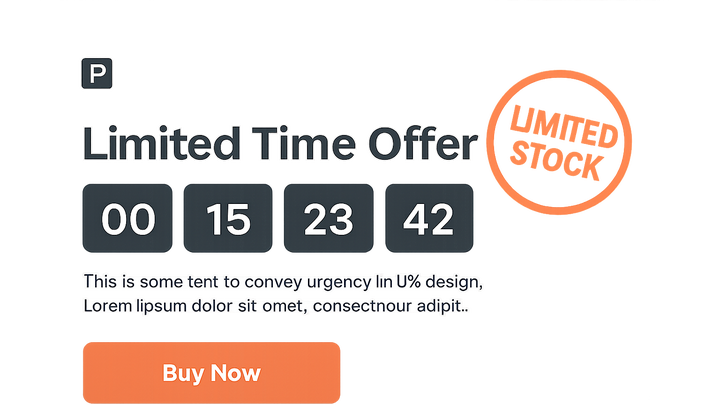Published on 2025-06-29T20:37:39Z
What is Urgency? Examples of Urgency in CRO/UX/SEO
The concept of urgency is a psychological trigger used in conversion rate optimization (CRO), user experience (UX), and search engine optimization (SEO) to encourage immediate action. Urgency manifests through time-sensitive elements like countdown timers, limited-time offers, and stock scarcity indicators. When applied effectively, urgency reduces decision paralysis, increases click-through and conversion rates, and can signal fresh content to search engines. Tools like Prevue.me can analyze your site and spot areas where urgency cues are missing or could be strengthened. However, urgency must be used ethically and balanced carefully to maintain trust and avoid user fatigue.
Urgency
Urgency is a psychological trigger that drives immediate action through scarcity and time-bound incentives in CRO/UX/SEO.
Why Urgency Matters in CRO/UX/SEO
Urgency taps into core psychological principles to prompt faster decision-making and action. By creating a perception of scarcity or time-sensitivity, websites can reduce hesitation and improve key metrics. In SEO, time-bound or seasonal content can boost relevance for trending queries. Using prevue.me, you can identify pages lacking urgency cues and discover opportunities to enhance them.
-
Psychological triggers
Urgency leverages scarcity, fear of missing out (FOMO), and loss aversion. These principles make users perceive higher value and act quickly to avoid potential regret.
- Scarcity:
Limited availability increases perceived value and motivates users to act before supplies run out.
- Fomo:
Showing that others are acting creates social proof and a desire not to be left behind.
- Scarcity:
-
Impact on conversion rates
Websites that implement urgency elements often see improved click-through rates and higher conversions. Small tweaks like a timer or deadline can yield significant uplifts.
- Cro metrics:
Track changes in conversion rate, average order value, and cart abandonment to measure urgency impact.
- Ux improvements:
Clear, urgent messages guide users smoothly through the decision process.
- Cro metrics:
-
Seo benefits
Fresh, time-sensitive offers can rank for trending keywords and attract timely search traffic, signaling search engines that content is current.
- Seasonal campaigns:
Leverage holidays or events to capture search interest.
- Limited-time offers:
Optimize landing pages around expiring promotions for targeted search queries.
- Seasonal campaigns:
Implementing Urgency Techniques
There are multiple ways to infuse urgency into your site. From dynamic countdown timers to real-time stock indicators, each technique must be designed thoughtfully to maximize impact without harming user trust.
-
Countdown timers
Timers show a ticking clock, creating a real-time sense of scarcity.
- Design considerations:
Ensure the timer is visible, matches your brand, and doesn’t distract from the call-to-action.
- Technical implementation:
Use JavaScript to dynamically update timers:
<div id="countdown"></div> <script> const endDate = new Date('2025-07-10T00:00:00').getTime(); const timerEl = document.getElementById('countdown'); setInterval(() => { const now = new Date().getTime(); const distance = endDate - now; const days = Math.floor(distance / (1000*60*60*24)); const hours = Math.floor((distance % (1000*60*60*24)) / (1000*60*60)); const minutes = Math.floor((distance % (1000*60*60)) / (1000*60)); timerEl.innerHTML = `${days}d ${hours}h ${minutes}m left`; }, 60000); </script>
- Design considerations:
-
Limited-time offers and promotions
Display clear end dates on discounts or bonuses to push users toward immediate action.
- Messaging:
Highlight deadlines with bold text and contrasting colors.
- Alignment with value proposition:
Ensure the offer remains compelling and relevant to the user’s needs.
- Messaging:
-
Stock scarcity indicators
Show low inventory levels to instill a fear of missing out on popular items.
- Real vs artificial scarcity:
Be honest about availability to maintain trust.
- Updating in real-time:
Sync inventory data to prevent overselling and disappointment.
- Real vs artificial scarcity:
-
Exit-intent pop-ups
Trigger offers when users attempt to leave, giving them a final incentive to stay or buy.
- Offer relevance:
Tailor pop-up deals to the user’s viewed content for higher engagement.
- Timing and frequency:
Avoid overuse to prevent annoyance and bounce increases.
- Offer relevance:
Testing and Measuring Urgency
Validating urgency tactics requires rigorous testing and analysis. Use A/B tests, heatmaps, and funnel analytics to see what resonates.
-
A/b testing urgency elements
Compare variations of timers, messages, and placements to find the highest-performing combination.
- Key metrics:
Monitor conversion rate, click-through rate, and bounce rate.
- Segment analysis:
Analyze results for new vs returning visitors to tailor strategies.
- Key metrics:
-
Heatmaps and user session recordings
Visualize where users look and click to assess urgency element visibility and effectiveness.
- Attention maps:
See if countdowns or badges attract eyes in the desired order.
- Session playback:
Watch real user interactions to uncover hesitation points.
- Attention maps:
-
Funnel analysis
Track how urgency influences drop-off rates at each stage from landing page to checkout.
- Checkout abandonment:
Measure reductions in cart abandonment after adding urgency cues.
- Form completion rates:
See if time pressure boosts or hinders sign-up forms.
- Checkout abandonment:
Common Pitfalls and Best Practices
Misusing urgency can harm brand reputation and trust. Follow best practices to maintain credibility and user satisfaction.
-
Overuse and message fatigue
Bombarding users with urgency cues leads to desensitization and annoyance.
- Balance and harmony:
Integrate urgency sparingly alongside other persuasive elements.
- A/b test frequency:
Adjust the volume of urgency cues based on performance data.
- Balance and harmony:
-
False scarcity risks
Fabricating low-stock or time-limited offers can erode trust and invite backlash.
- Transparency:
Clearly state actual stock levels or offer expirations.
- Alternative approaches:
Use waitlists or restock notifications instead of false shortages.
- Transparency:
-
Accessibility considerations
Ensure that urgency indicators are perceivable and operable by all users, including those using assistive technologies.
- Timer aria labels:
Provide descriptive labels for countdowns to screen readers.
- Visual contrast:
Maintain sufficient color contrast for text and timers.
- Timer aria labels:
-
Ethical use
Avoid manipulative tactics that exploit vulnerable users and comply with advertising standards.
- Compliance with advertising standards:
Follow guidelines to ensure that urgency claims are truthful and transparent.
- User trust and retention:
Build long-term relationships by balancing urgency with authenticity.
- Compliance with advertising standards:
